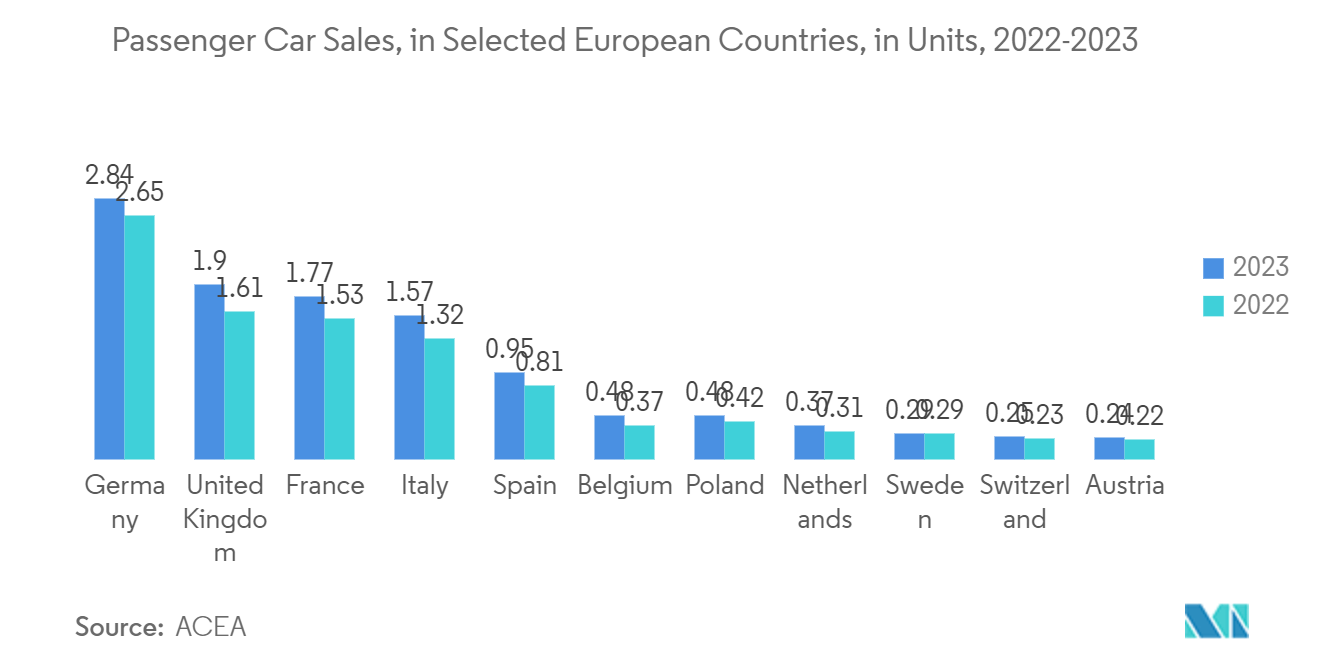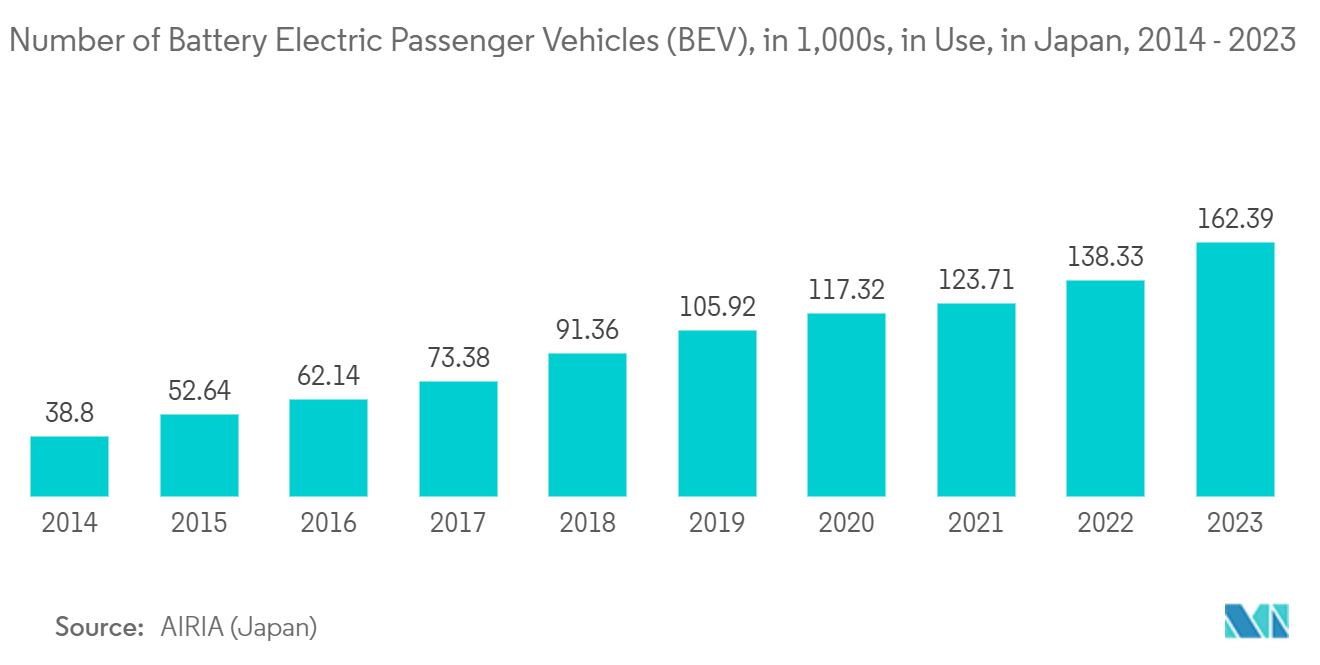Market Trends of Asia-Pacific Semiconductor Device Industry
The Automotive Segment is Expected to Drive the Market's Growth
- Semiconductor devices can display several valuable properties. These include passing current easily in one direction rather than the other, sensitivity to light or heat, and displaying variable resistance. Devices made from semiconductors are used for amplification, switching, and energy conversion because of their ability to be modified through doping or by applying light or electrical fields.
- Automobiles are increasingly becoming computers on wheels. They now include heads-up displays, autonomous driving aids, sensors, cell phone and communication integration, and high-performance elements in their engines.
- Innovations in automotive connectivity, electrification, and autonomous driving are primarily achieved by integrating more electronics powered by a significant, growing silicon content. As vehicle production increases, the market growth for semiconductors in the automotive sector is expected to rise.
- Asia-Pacific is one of the most important markets for the automobile industry, owing to an increase in urban population and spending power. According to the China Association of Automobile Manufacturers (CAAM), approximately 965,000 passenger vehicles and 216,000 commercial automobiles were sold in China in April 2022. Such massive vehicle sales will allow the studied market to grow.
- Further, the NITI Aayog and Rocky Mountain Institute (RMI) predict that India's electric vehicle (EV) finance sector will reach INR 3.7 lakh crore (USD 50 billion) by 2030. Major automakers have begun investing extensively in various parts of the industry to meet rising demand in recent months. For instance, in March 2023, Taiwan-based tech company Foxconn announced that it is looking to invest in developing semiconductors and EVs in India.
- Additionally, the country is witnessing various partnerships by major vendors to boost the supply chain. In June 2022, Renesas Electronics Corporation announced a strategic partnership with Tata Motors Ltd. and Tejas Networks Ltd. to focus on developing semiconductor solutions for technologies across automotive, Internet of Things (IoT), and 5G Systems. Such developments would boost the penetration of semiconductor devices in the region's automotive sector.
- Further, the growth trajectory of fully-autonomous automobiles is expected to be heavily influenced by several factors, including technology advancements, consumer willingness to accept fully-automated vehicles, pricing, and suppliers and original equipment manufacturers' (OEMs) capacity to address significant concerns about vehicle safety. The growing demand for EVs in the Asia-Pacific region would cause an upsurge in demand for semiconductor devices.
- For instance, according to AIRIA (Japan), as of March 31, 2022, the number of battery electric passenger cars reached over 138.33 thousand, increasing from around 125.86 thousand in the previous year in Japan.

China is Expected to Witness a High Market Growth Rate
- In China, advancing technologies has contributed to the advancement of various consumer electronics, medical devices, telecom and communication devices, and automobiles, among others. With the launch of 5G services in the country, the necessity for the smartphone, among other things, has been increasing.
- According to the Ministry of Industry and Information Technology (MIIT), China aimed to have 2 million installed 5G base stations in 2022 to expand the country's next-generation mobile network. The Chinese mainland currently has approximately 1.425 million installed 5G base stations that support over 500 million 5G users nationwide, making it the biggest network in the world, as per MIIT. The increase in the implementation of 5G in the region is also anticipated to promote the demand for 5 G-enabled devices, thereby increasing the need for semiconductor devices in China.
- Further, according to China's State Council's "2014 National Integrated Circuit Industry Development Guidelines,' it aims to become a global leader in all semiconductor industry segments by 2030. Additionally, the "Made in China 2025" initiative maintains achieving knowledge with regard to advanced semiconductor manufacturing as a crucial component of China's future economy and society. It is highly focused on the strategy to build a strong manufacturing nation worldwide.
- The initiative is expected to encourage local and foreign companies to invest in the Chinese market across various segments, including integrated circuits. The initiative also prompts the government bodies to boost research and development activities so that China can rely on its own companies for core technologies rather than overseas ones. This is set to propel innovation in the semiconductor manufacturing industry, thereby boosting the growth of the semiconductor devices market.
- Moreover, as per the International Trade Administration (ITA), China continues to be the world's largest vehicle market in terms of manufacturing output and annual sales, with domestic production expected to reach approximately 35 million vehicles by 2025. Such an increase in the demand for automobiles in the region is also likely to push the need for the studied market further.
- China is one of the largest manufacturing giants in the number of manufacturing units operational for many industries in the Asia Pacific region. With the US-China Trade war, China has been focusing on motivating microcontrollers' domestic manufacturing. Hence, local manufacturers are following large-scale policies of vehicle electrification and others, creating high demands for microcontroller units (MCUs) and boosting domestic MCU manufacturing.
- For instance, in April 2022, Nanjing SemiDrive Technology Ltd. introduced the E3 series of advanced reduced instruction set computer (RISC) machine, advanced RISC machine (ARM)-based automotive microcontrollers. These are aimed at drive-by-wire chassis, battery management system (BMS), brake control, advanced driver-assistance systems (ADAS)/autonomous driving motion control, head-up (HUD), liquid-crystal display (LCD) instrumentation, and streaming media vision systems.
- Similarly, in April 2022, BYD, another semiconductor manufacturer from China, launched its new BS9000AMXX series of 8-bit MCU chips for vehicles. According to the company, the BS9000AMXX series is an 8-bit general-purpose MCU, and the chip uses an S8051 core with a central frequency of up to 24MHZ. Such developments are anticipated to offer lucrative opportunities for the region's studied market growth.a


